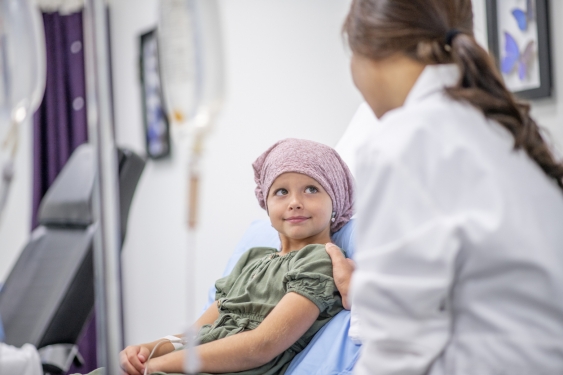Researchers derive novel treatment approach to selectively target cancer cells
A new method developed by scientists at the Children’s Cancer Institute (CCI) and UNSW Sydney is solving a decades-old clinical problem: getting treatment drugs to act selectively on cancer cells in the body. Published today in Science Translational Medicine, the research paves the way to safer and more effective treatment options for children with aggressive blood cancers, and potentially other types of cancer as well.
Chemotherapy is the mainstay of treatment for leukaemia, the most common blood cancer in children. However, while chemotherapy can be very effective for certain types of leukaemia, it is not as effective for some other types, known as ‘high-risk’ leukaemias. Treatment for high-risk leukaemias generally involves high doses of toxic drugs that flood the body, affecting cancer cells and healthy cells alike. This often leads to severe side effects, as well as lifelong health issues in survivors.
“Finding a way to make treatment drugs act more selectively on cancer cells is the key to improving treatment success while reducing toxicity in children treated for high-risk leukaemia,” said lead researcher Professor Maria Kavallaris AM, from UNSW Medicine & Health and CCI.
“By specifically targeting leukaemia cells, we can make treatment more effective, as well as much safer to use in children.”
Specific targeting using antibodies
In the newly published research, scientists at CCI, UNSW and collaborating organisations used a special formulation of the cancer drug, doxorubicin (Caelyx), in which the drug is encapsulated in tiny particles called liposomes. To this formulation, they added ‘bi-specific’ antibodies – antibodies capable of recognising and attaching to the drug at one end and to cancer cells at the other end, effectively acting as a bridge between the two. Known as a targeted drug delivery system, this acts to deliver the drug to its target, in this case leukaemia cells, where the drug can do its job and kill the cells.
“What is particularly useful about this new approach is its flexibility,” said the study’s first author, Dr Ernest Moles, from UNSW Medicine & Health and CCI.
“We can use this system to target any leukaemia, including the high-risk subtypes that are killing Australian children every year. Rather than having to design a completely new therapeutic each time, all we need do is change the antibody bridge, and we can target the same drug to any child’s blood cancer.
“What’s more, this approach could allow us to counter drug resistance in an individual patient. If the cancer cells in a child try to evade chemotherapy by altering their cell surface, we can modify the targeted drug delivery system so it is able to recognise that altered cancer cell. There will be no easy escape.”
Effective in cell and mouse models
The new approach was shown to work well not only in leukaemia cells grown in the laboratory, but also in living models of disease called ‘patient-derived xenografts’, where leukaemia cells are taken from children with the disease and grown in specially bred mice. In these models, the targeted drug delivery system was found not both reduce the amount of leukaemia, and to also to significantly prolong survival – in some cases, up to four-fold.
The researchers believe this same approach could be used to improve the selectivity of a whole range of new-generation therapeutic agents, not just chemotherapy drugs, opening the way to offering children alternative therapeutic options that are much safer than those currently on offer. They are also excited about the potential contribution it could make in the dawning era of precision medicine.
“In the future, it may be that each child diagnosed with leukaemia can have their treatment targeted to their specific subtype, based on the analysis of a blood sample,” Professor Kavallaris said.
“We believe the controlled targeting of nanotherapeutics represents a real milestone in the treatment of childhood cancers, and we’re very optimistic about where this could lead to.
“We’ll now be working towards developing this research for clinical translation, in collaboration with our partners at UNSW Australian Centre for NanoMedicine. In this study we’ve combined clinically approved drug-loaded nanoparticles with bi-specific antibodies which will help accelerate the clinical development and approval process.”
Reducing treatment toxicity
Matt Weston and his son Jacob, who is currently being treated for acute lymphoblastic leukaemia, know all too well the significance of this research.
“I’ve followed this research project closely, and I’ve been absolutely blown away by the work of Maria, Ernest and the team at Children’s Cancer Institute,” Matt said.
“Having experienced firsthand how toxic the chemo treatment is through my son’s journey, I could tell you some horror stories of the side effects even with a standard risk diagnosis. For those with high-risk leukaemia, not only is the treatment far more toxic, but their chances of survival are much lower as well.
“I think about those children and their families all the time, and to know that we are closer to improving the treatment, reducing the toxicity, and improving their chances of survival gives me great hope.”
Jacob has already been through several cycles of chemotherapy over the past eight months and has experienced a range of debilitating side-effects. But it’s not over yet. He has another 16 months of maintenance therapy to go, then it will be another three years beyond that before he gets the all-clear.
“It’s a long road ahead,” Matt said.

